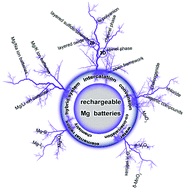当前位置:
X-MOL 学术
›
Chem. Soc. Rev.
›
论文详情
Our official English website, www.x-mol.net, welcomes your feedback! (Note: you will need to create a separate account there.)
A critical review of cathodes for rechargeable Mg batteries
Chemical Society Reviews ( IF 46.2 ) Pub Date : 2018-10-19 00:00:00 , DOI: 10.1039/c8cs00319j Minglei Mao 1, 2, 3, 4, 5 , Tao Gao 1, 2, 3, 4 , Singyuk Hou 1, 2, 3, 4 , Chunsheng Wang 1, 2, 3, 4
Chemical Society Reviews ( IF 46.2 ) Pub Date : 2018-10-19 00:00:00 , DOI: 10.1039/c8cs00319j Minglei Mao 1, 2, 3, 4, 5 , Tao Gao 1, 2, 3, 4 , Singyuk Hou 1, 2, 3, 4 , Chunsheng Wang 1, 2, 3, 4
Affiliation

|
Benefiting from a higher volumetric capacity (3833 mA h cm−3 for Mg vs. 2046 mA h cm−3 for Li) and dendrite-free Mg metal anode, reversible Mg batteries (RMBs) are a promising chemistry for applications beyond Li ion batteries. However, RMBs are still severely restricted by the absence of high performance cathodes for any practical application. In this review, we provide a critical and rigorous review of Mg battery cathode materials, mainly reported since 2013, focusing on the impact of structure and composition on magnesiation kinetics. We discuss cathode materials, including intercalation compounds, conversion materials (O2, S, organic compounds), water co-intercalation cathodes (V2O5, MnO2etc.), as well as hybrid systems using Mg metal anode. Among them, intercalation cathodes are further categorized by 3D (Chevrel phase, spinel structure etc.), 2D (layered structure), and 1D materials (polyanion: phosphate and silicate), according to the diffusion pathway of Mg2+ in the framework. Instead of discussing every published work in detail, this review selects the most representative works and highlights the merits and challenges of each class of cathodes. Advances in theoretical analysis are also reviewed and compared with experimental results. This critical review will provide comprehensive knowledge of Mg cathodes and guidelines for exploring new cathodes for rechargeable magnesium batteries.
中文翻译:

镁可再充电电池阴极的严格审查
得益于更高的容量(Mg为3833 mA h cm -3,Li为2046 mA h cm -3)和无枝晶的Mg金属阳极,可逆Mg电池(RMB)对于锂离子电池以外的应用而言是一种有前途的化学方法。但是,由于没有任何实际应用的高性能阴极,人民币仍然受到严格限制。在本次审查中,我们对镁电池正极材料进行了严格而严格的审查,该报告主要自2013年以来发表,重点关注结构和成分对镁离子动力学的影响。我们讨论阴极材料,包括插层化合物,转化材料(O 2,S,有机化合物),水共插层阴极(V 2 O 5),MnO 2等),以及使用Mg金属阳极的混合系统。其中,根据Mg 2+在框架中的扩散途径,将嵌入阴极进一步分为3D(Chevrel相,尖晶石结构等),2D(层状结构)和1D材料(聚阴离子:磷酸盐和硅酸盐)。这篇评论并没有详细讨论每篇已发表的作品,而是选择了最具代表性的作品,并重点介绍了每种阴极的优缺点。还对理论分析的进展进行了综述,并与实验结果进行了比较。这项重要的评论将提供有关Mg阴极的全面知识,以及有关探索可充电镁电池新阴极的指南。
更新日期:2018-10-19
中文翻译:

镁可再充电电池阴极的严格审查
得益于更高的容量(Mg为3833 mA h cm -3,Li为2046 mA h cm -3)和无枝晶的Mg金属阳极,可逆Mg电池(RMB)对于锂离子电池以外的应用而言是一种有前途的化学方法。但是,由于没有任何实际应用的高性能阴极,人民币仍然受到严格限制。在本次审查中,我们对镁电池正极材料进行了严格而严格的审查,该报告主要自2013年以来发表,重点关注结构和成分对镁离子动力学的影响。我们讨论阴极材料,包括插层化合物,转化材料(O 2,S,有机化合物),水共插层阴极(V 2 O 5),MnO 2等),以及使用Mg金属阳极的混合系统。其中,根据Mg 2+在框架中的扩散途径,将嵌入阴极进一步分为3D(Chevrel相,尖晶石结构等),2D(层状结构)和1D材料(聚阴离子:磷酸盐和硅酸盐)。这篇评论并没有详细讨论每篇已发表的作品,而是选择了最具代表性的作品,并重点介绍了每种阴极的优缺点。还对理论分析的进展进行了综述,并与实验结果进行了比较。这项重要的评论将提供有关Mg阴极的全面知识,以及有关探索可充电镁电池新阴极的指南。


























 京公网安备 11010802027423号
京公网安备 11010802027423号